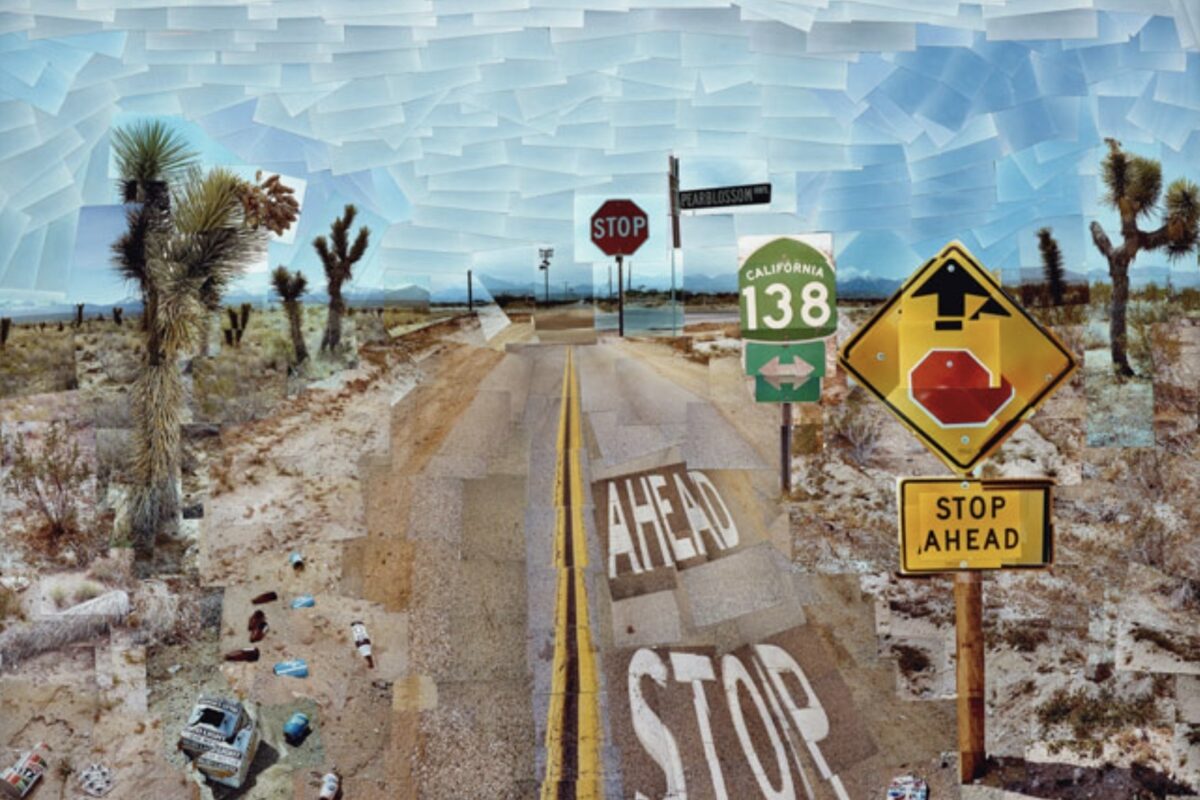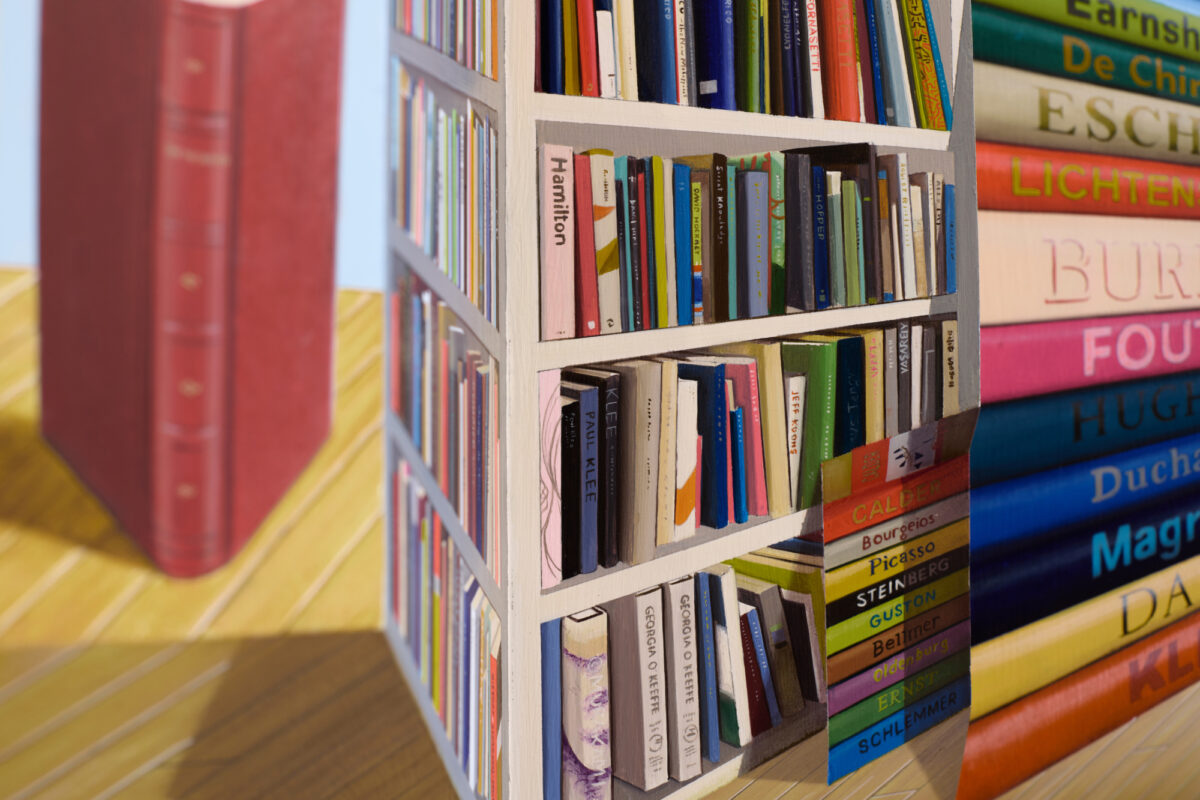“SHOXTON and WHOREDITCH have been without the city walls for 500 years of theatre, Markets and market gardens, Hospitals and hospitality, Fashions and the unfashionable,Nonconformists, Boos and booze, Real work and The pleasure of leisure…Don’t let them takeover –They love takeovers –Our Ditch, Put out our Light and Replace it with another Deeply dull erection. Just like the other ones.”

Window Shopping, oil and collage on board construction, 2021.
So wrote Patrick Hughes back in the early days of the 21st-century when, as a long-term resident of London’s East End, he began to see the decay receding in favour of anodyne developments. Thankfully, Great Eastern Street (home to Hughes and his wife Dr Diane Atkinson) retains much of its former character, and the artist has added plenty of his own: these days, you can peep through the windows of his street-facing studio and see new work taking shape or visit the adjacent viewing area by appointment. It’s been 25 years since Hughes moved to the area and sixty since his first exhibition, but his productivity shows no sign of abating.
Setting up home and studio in 1990s Shoreditch was trailblazing, but Hughes has always been ahead of the curve. He was the first artist on the books of London’s renowned Flowers Gallery, and lived and worked for a while at New York’s notorious Chelsea Hotel (describing it as a ‘vertical village’ and enjoying the camaraderie of artist friends and neighbours).


Detail of Cuboids, one of Hughes' new originals that will be on show.
Simon Kallas
Pop Art and perspective
Hughes was also a pioneering figure on the Pop Art scene. Back in 1961, his first exhibition at the Portal Gallery in Mayfair was also the first ever solo Pop Art exhibition – and shortly afterwards he invented his revolutionary technique, Reverspective. This trademark method involves painting onto 3D shapes to create the idea of perspective as the viewer moves around the work (Hughes returned to and honed the method a few decades later, using digital software). Speaking to the website Stirworld, Hughes explained, “the illusion is made possible by painting the view in reverse to the relief of the surface, that is, the bits that stick farthest out from the painting are painted with the most distant part of the scene”.
Though Hughes’s technique has been linked to Op Art (a key movement during the 1960s), Reverspective is unique because viewers are able to engage in the illusion by moving around the work to feel the full effect, rather than simply by looking at it straight on. Because of this key difference, Hughes terms his paintings ‘full body illusions’.
The artist’s obsession with looking at things upside down and the wrong way round has its roots in a childhood memory. Sheltering from WWII bombs in the cupboard under the stairs of his Birmingham home, Hughes would look up and consider the staircase from underneath – a different way of seeing things that has informed his thought process and themes throughout his career.

A small preview of Patrick Hughes: The Perspective Paradox.
Simon Kallas
Rainbow warrior
Between his first Reverspective and his return to the idea in the 1990s, Hughes made a series of highly successful and instantly recognisable rainbow paintings, of which around one million postcards and 10,000 screenprints have been sold. Chiming with 1970s ideas of psychedelia and free love, the works were often viewed as positive and cheerful. Speaking to The Guardian in 2003, Hughes reflected on his use of the motif, saying “[They] are a revelation: different wavelengths that are seen as colours. It is pure magic.”
However, there’s more to Hughes’s rainbows than meets the eye: they also explore the paradox of pinning a fleeting experience into something solid, and pair the familiar with the strange or macabre (consider, for example, Cry Me A River, in which rainbows pour out of a skull’s eyes like tears).
In this way, they link with Hughes’s Reverspectives, which often feature popular artworks by the likes of Banksy, Hirst and Warhol in strange, imagined galleries. The familiar subject matter draws the viewer in and invites them to engage in Hughes’s unpopulated museums, streets and libraries.

Collecting, detail, oil on board construction, 2021.
Simon Kallas
In the gallery
These days, Patrick Hughes’ works are in collections including The British Library, Tate, the V&A and the British Academy in London; the Gallery of Modern Art, Glasgow; The Würth Museum, Künzelsau and the Baker Museum, Florida. He continues to exhibit across the globe. Our exhibition, The Perspective Paradox, will run from October 29 to December 16.
To gain early access to the exhibition catalogue and viewing room or RSVP to the private view, register your interest through the exhibition page below.
More editorials about Patrick Hughes
Artists
Artist Influences
22 May 2023 | 3 min read
Artists
The Perspective Paradox | In Conversation with Patrick Hughes
15 Dec 2021
Artists
Weird Science: Reverspective
15 Nov 2021
Artists
The Perspective Paradox | A Look at the Private View
2 Nov 2021
Artists
Introducing | Patrick Hughes: The Perspective Paradox
6 Oct 2021
Artists
Artists to Watch | 2021
3 Jan 2021
Artists
Five Questions With | Patrick Hughes
12 Nov 2020
More from Artists
Artists
The Psychology of Kusama
14 Jul 2025 | 3 min read

Artists
Decoded: David Shrigley
8 Jul 2025 | 2 min read

Artists
Is David Hockney the Most Important Living Artist?
2 Jul 2025

Artists
Top 10 Selling Warhol Sets
15 Jun 2025 | 2 min read

Artists
David Hockney | 5 Groundbreaking Moments
23 Apr 2025 | 3 min read

Artists
Yayoi Kusama breaks records with the most successful exhibition in Australian history
17 Apr 2025

Artists
An Interview With Mark Vessey
9 Apr 2025 | 7 min read

Artists
Yayoi Kusama at 96: A Celebration of the World's Best-Selling Female Artist
22 Mar 2025 | 3 min read

Artists
Super Woman | Why Tracey Emin standing up to the haters is good for you too
8 Mar 2025

